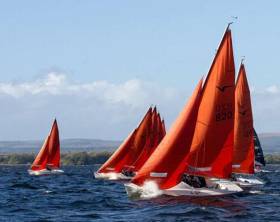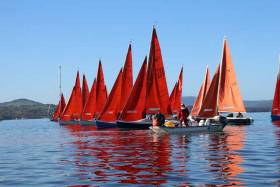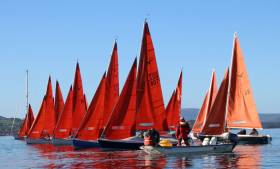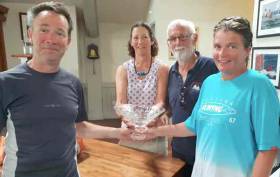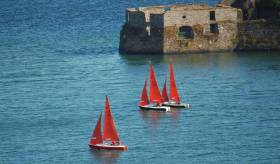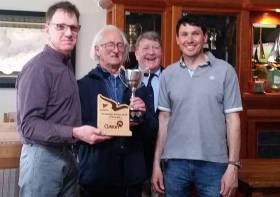Displaying items by tag: squib
Bumper Entry for Squib Easterns at Howth Yacht Club
Howth Yacht Club hosted nineteen boats for the Squib Eastern Championships sponsored by Provident CRM last weekend writes Ronan MacDonell, HYC Squib Class Captain.
The event was run alongside the J24 Easterns which made for a busy clubhouse. While the weather played ball for the most part, wind conditions did offer a stern test for the race management team, ably led by Derek Bothwell. We had a series of shifts on Saturday which caused delays but the fleets were very grateful that the race management team were patient.
As Afloat reported previously, the Squibs sailed trapezoid courses for the weekend which was a change from the normal windward/leeward. Crews felt it the most as there was a lot of kite work over both days. We completed five races.
Race 1 got away clean and was dominated by Inshallah (Dave Eccles and Michael Wright). Volante (Simon Watson & Jordy Winters) took 2nd which was a great result for them, followed by Quickstep (Gordon Patterson and Ross Nolan).
After a delay, Race 2 got underway with a much-changed wind direction. There was a strong ebb now flowing and the Squib fleet was jumpy. We pushed the line and ended up with two recalls. Derek was forced to whip out the U Flag, followed by the Black Flag, which claimed three deserving victims. Game over for them! There was a robust tussle for the race win finally claimed by Outlaw (Ian Travers and Keith O’Riordan). Allegro (Collie Dunne and Fiona Ward) and Quickstep completed the podium positions.
Within minutes of the completion of the second race, Race 3 was in sequence, with everyone starting to look forward to a beer after a long day on the water. A Howth boat Tears in Heaven sailed by Peter Wallace and Martin Weatherstone burst out of the blocks and led from the traps to the winning post. Peter couldn’t wait to get to his usual tipple of “Howth Gin and Slimline”. Inshallah and Allegro made up the podium and we all faced a robust sail back to the marina.
The weather on Sunday was as good as it has been on the East coast of late. Light conditions with frequent sunny spells. Race 4 started in a fickle breeze which died off considerably downwind. The leading boats got around the bottom mark before the worst of the lull. The calm lasted about 10 minutes and soon there was breeze enough to get us upwind again. The race management team had the experience to shorten us up and tick Race 4 as “Done”. The race was won by Prodigal followed by Quickstep and Firecracker (Stephen Bridges and Kyle, Killyleagh YC).
A brief pause ensued before Race 5 got underway. The increasing breeze brought with it a modified direction, so the mark layers were busy again. The wind remained fickle at times, so tidal flows made the downwind legs tricky and then it steadied again to get us home. Outlaw got the gun followed by Periquin (Noel Colclough and Vincent Delaney) followed by Quickstep.
Congratulations to Gordon Patterson and Ross Nolan taking the Championship trophy back to Royal North of Ireland YC.
The Silver fleet was won by 3point9 Emmet Dalton and Peter Malone from HYC (Peter in his first Squib event!). Howth was represented by 9 boats, one of which was sailed by a crew from RNIYC. It is the best Howth representation at a regionals for quite a while. Results did not go our way but the positive is the re-emergence of the fleet on its 40th Anniversary in HYC. After a few years off the circuit, we will need a little time to get back up to speed!!
The event was awarded Silver Level Certification by Sailors For The Sea. The Sailors For The Sea Award for Sustainability went to Noel Colclough for retrieving more plastic from the sea than any other competitor.
Full Results here
This ever-popular Squib Championship hosted by Howth Yacht Club was supported by a somewhat unusual list of competitors, firstly Peter Wallace, current Irish Squib Champion’s Toy for the Boys broke free from it’s moorings and went up on the rocks at Belfast Lough three days before the event, secondly, Gordon Patterson couldn’t make up his mind which of his two boats was fastest, so he brought the hull of Quickstep III and sails from former 1994 UK Championship winner Fagin. Other unfamiliar boats included Outlaw which has lost its colourful paint job and in order to be inconspicuous on starting lines has returned to British Standard off-white.
There was an entry of nineteen boats, seven from the home club where the revived Squib fleet is growing rapidly, four hot boats from the Royal North of Ireland YC on Belfast Lough, three from Killyleagh Y.C. on Strangford Lough, two from Kinsale, and one from Kilbarrack S.C where the average water depth is about 300mm., one from Lough Derg Y.C. and one from the Royal St George Y.C.
Various weather forecasts suggested both easterly and westerly winds which were to back/ veer to the south. Forecasters seemed unsure about the strength of the wind but they knew that it would never reach gale force.
Race one which was held in westerly winds of Force two with flat water and strong tides was won by former Champion David Eccles in Inshallagh, followed by Simon Watson in Volante and Gordon Patterson and Ross Nolan in Quickstep III third. With northern boats taking the top three places, was this to be the pattern, yet again, for the championship.
Race two in similar conditions after the wind swung towards the south-west was won by Ian Travers in Outlaw, followed by Colm Dunne and Fiona Ward in the beautiful Allegro, boat boats from Kinsale, venue for the UK and Irish Squib Nationals next year.
The wind clocked around over a period of more than an hour from 250, to 180 and settled at about 150 degrees. It takes a patient race officer team to wait for the wind to settle to a championship standard. In the third race Peter Wallace and Martin Weatherstone were coming to terms with the borrowed Tears in Heaven which won the third race with their own Hyde sails from Toy for the Boys from Inshallagh and Allegro.
Overnight the results brought up some surprises due to the number of ‘U’ flag offenders, with Inshallagh in first place, Quickstep second and Noel Colclough’s consistent Periquin third.
On Sunday strong winds were expected from the south- but they never came. The competitors had a repeat of the previous days Force 2 winds which again backed all day. In race four the wind fell away completely and on a shortened course, was won by Greg Bell’s Prodigal crewed by Squib veteran Fred Campbell, Quickstep was second and Steve Bridges’ Firecracker third. At this point each race had a different winner.
The final race was won by Outlaw, with Periquin second and Quickstep III. Quickstep III had done enough to win the championship.
Download results below
Squibs’ Golden Jubilee Will Get Full Treatment at Cultra
The 19ft–Squib keelboat is quite often raced with ferocious competitiveness which is almost frightening for those of us who bought them many years ago as handy little boats which worked as an ideal family day-sailer while providing some club One-Design racing as a useful option writes W M Nixon.
The alleged story of their origins has a certain irresistible charm. It’s said that in 1967 or thereabouts, the local GP in Burnham-on-Crouch - that total sailing place in among the many rivers and creeks of Essex - had the complete rig for an Enterprise Dinghy, but no hull to go with it.
However, having decided that his dinghy-sailing days were over, the doctor was yarning down the pub with the local small boat designer Oliver Lee, and the upshot of it was that Lee agreed to design a smaller version of his proven Ajax 23 in order to create a comfortable little keelboat which could use that redundant Enterprise rig.
You wouldn’t dream of measuring up an actual Enterprise rig against what finally emerged on the Squib, for fear of blowing that charming myth out of the water. But in any case, when the new boat soon proved so popular that classes started developing almost immediately, they were using distinctive sails in a tanned fabric such as you see on old gaffers, as it’s said some sailmaker had mistakenly over-ordered a stock of the stuff, so they were very competitively priced.
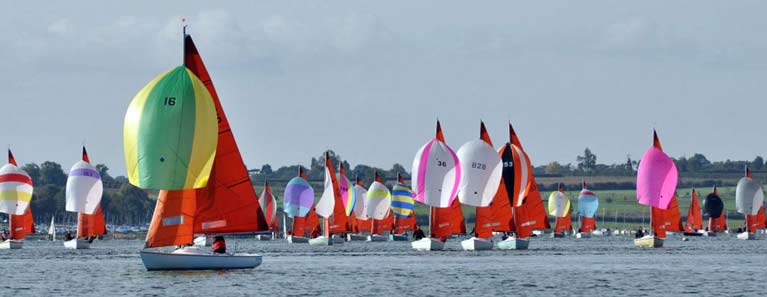 Squibs in their dozens…..ever since the design appeared, there have been those who wanted a bigger spinnaker, while others want to change the sail colour, but the Squib remains her own very distinctive self
Squibs in their dozens…..ever since the design appeared, there have been those who wanted a bigger spinnaker, while others want to change the sail colour, but the Squib remains her own very distinctive self
The odd boat turned up here and there in Ireland – there’s a rumour one of the first was seen in West Cork – but the first Club to seriously adopt the class was Royal North of Ireland YC at Cultra on Belfast Lough. And they certainly didn’t let the grass grow under their feet – they’d Squibs racing in significant numbers by 1969, and in the years since, they’ve been far and away the most frequent winners of the Irish championship.
Admittedly it was when Howth hosted the British and Irish Championship in 1995 that the Squibs achieved a hundred boats-plus on the starting line for the first time, but down the ages it is the Cultra sailors who have most assiduously kept the faith, and this year they’re celebrating the Golden Jubilee of their fleet with a turbo-powered three day event for the 2019 Irish Nationals at Cultra on August 2nd to 4th, details here
The Squib is so broadly spread all over Ireland that we can get typical photos from many centres showing their versatility, but my favourite continues to be one taken at Dromineer on Lough Derg where the little boats are revelling in Autumn sailing at its best.
It now has added interest, as it shows a classic Lough Derg shoreline. Yachting historian Vincent Delany was referring to this background when he commented that the recently-sold Montagu Dawson painting of International 6 Metres supposedly racing on Lough Derg featured a shoreline which no Lough Derg sailor would recognise. Enough said.
How Slack Can You Go With a Forestay & Still Get Benefit?
A long time ago when I brought the first very second-hand Squib to Howth Yacht Club in 1979, things were different writes WM Nixon. After all, it was forty years ago (there’s another local class anniversary for you), and I’d spent the 1970s either racing offshore under IOR as it then was, with 150% genoas, or cruising in good old-fashioned boats where a taut forestay was likewise de rigeur.
Sometimes crews were so keen to straighten the forestay on hot offshore racers that they found their over-use of the hydraulic backstay tensioner was slowly driving the foot of the mast through the bottom of the boat. As for narrowing the slot between jib and mainsail, it was thought to look scruffy - “I don’t like the cut of his jib” had real meaning.
So it was interesting to note the recent North Sails piece on Afloat.ie about the benefit of giving the forestay a little bit of sag to help performance in light airs. Just how much sag you should give presumably depends on many factors, but on boats where the headsail is really only a jib, such as the Etchells 22 or Squib, it seems that anything goes.
Certainly, I felt distinctly prehistoric over the years, in becoming aware of the way Squibs were experimenting with slack forestays and the clew hauled well inboard. It looked plain wrong. But it worked. That said, in the quaint photo of 40 years ago where I’m helming in considerable comfort thanks to a marvellous crew in Ian Jackson, who could sit right out ramrod straight for as long as was needed, there certainly were other Squibs out racing, but there doesn’t seem to be one in front of us…….
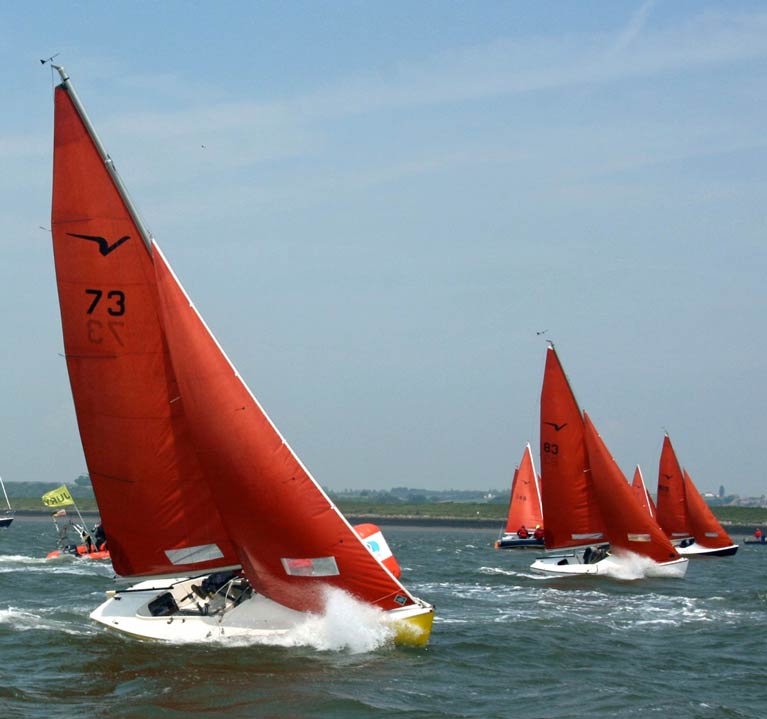 Do you like the cut of his jib? Squib jib trim as it is today
Do you like the cut of his jib? Squib jib trim as it is today
Squib Fleet To Support Fun Fridays at the Royal St George Yacht Club
At the recent Dublin Bay Squib fleet AGM which was well attended by active members, the following decisions were taken:
- Members of the Squib fleet will ensure that the turn out of Squibs at Dublin Bay Sailing Club Thursday and Saturday races will be superior to 2018.
- It is expected that Allsorts and Karma will join the active fleet for club racing.
- Class Captain Noel Colclough and his team will be organising crew coaching at the beginning of the season.
- The Squib fleet will be supporting the Fun Fridays at the Royal St George Yacht Club.
- The Dublin Bay Squib Fleet will endeavour to find new owners for any boats currently for sale.
Patterson & Nolan Win Squib Inland Championships on Lough Derg
Lough Derg Yacht Club's Freshwater Championships in Dromineer last weekend was all about the weather! On Thursday and Friday when the teams were arriving from every part of Ireland, they were told to expect 100km/hr winds.
Fortunately, these winds did not materialise, and 21 one entries represented the best supported Squib event of the year, with three teams from Royal North of Ireland Yacht Club, three from Killyleagh Yacht Club, two from Kinsale Yacht Club, one from Baltimore Sailing Club, one from Howth Yacht Club, one from Glandore Harbour Yacht Club, one from Royal St George Yacht Club, and three from the home club. There were three very welcome visitors from Brexitland, one from Holyhead, one from Royal Norfolk and Suffolk Yacht Club and Dick Batt from Bosham. Two further entries didn’t arrive due to personal circumstances. Although there were no female helms, there were several female crews, including Fiona Ward in ‘Allegro’, Pamela Phelan in ‘Squib’, and Mary Faherty in ‘Sidewinder.’
"with only three races sailed, all race results counted"
Racing on Saturday took place in rain-drenched Dromineer Bay in shifty winds which varied from 4 to 8 knots. This made for difficult boat handling due to telltales being non- operational, and solar-powered compasses responding in the same manner. Over the duration of the day, the wind swung 180 degrees from the east through the south and then the west. Notwithstanding the conditions, there were three different winners. The PRO John Leech was persuaded by the competitors to abandon the fourth race due to the crews finding it difficult to concentrate under such conditions.
On Sunday the sun shone, but the wind stayed away- so the race which was started was abandoned by the PRO on the grounds of inadequate means of propulsion. Thus, with only three races sailed, all race results counted.
Full results downloadable below:
Breeze Expected as Flying Fifteens & Squibs Head for Lough Derg Yacht Club 2018 Finale
Lough Derg Yacht Club is hosting its annual Freshwater Keelboat Championships in Dromineer, County Tipperary this coming weekend with racing for Squibs and Flying Fifteens over two days.
The event is an end of season celebration and competition for sailors who love the autumnal conditions and the challenge of the vagaries of lake sailing.
Currently, the weather forecast indicates gusty, southerly winds on Saturday and Sunday
Competitors are travelling from as far afield as Norfolk, Holyhead, Strangford, Howth, Kinsale and Dun Laoghaire to join the local fleet.
LDYC Commodore John Leech is Race officer for the event.
Allegro Wins Kinsale Yacht Club Squib Battle
Kinsale Yacht Club hosted the Squib Southern Championships this weekend. Six races were sailed over the two days with different wind and sea conditions each day. Saturday had a 12 – 15-knot breeze coming from due east so there was a swell which made for testing conditions while Sunday saw gusts over 20 knots but flat seas as the wind was due north.
Race 1 saw Colm Dunne & Fiona Ward on Allegro dominate from the start with Ian Travers and Keith O’Riordan on Outlaw second and Denis and Brid Cudmore on Sensation third. With less than 3.5 mins between the last finisher and the warning signal for the next race Race Officer Peter Crowley had his team running like a well-oiled machine. Race two saw the lead boats reversed with Outlaw in command and Allegro in second. Bodacious with Jeff Cochrane and Finbarr O’Regan were battling with Sensation for third but Sensation prevailed.
Race four on Sunday had Allegro in front from the start. Sensation tacked up the middle of the course and gained several places to secure 2nd and Bodacious was third. Outlaw was 4th which meant that this was possibly his discard. Race 5 got underway and Allegro was 1st and Outlaw 2nd. Sensation was jockeying with Bodacious again but secured another 3rd.
Race six got underway with Allegro and Outlaw on equal points. They tacked up the beat covering each other. Outlaw got to the windward mark first on the final beat but Allegro caught him on the run and they arrived to the leeward mark together. Allegro managed to push Outlaw up after rounding and this gave Allegro the edge he needed to beat to the line and secure the championship.
The Cost of a Sailing Cruiser – ICRA – & 50 Years of Squibs
It’s still cold enough in boatyards to require determination to take off the covers, slide back the hatch and go below to start the annual preparation work. There are some more determined than others to have their boats ready to get the maximum out of the season but, having listened to a work colleague who presented me with a mathematical disassembly of the costs of owning a boat – the balance sheet he compiled in that cold analysis was on the financial red side - my emotional attachment to my boat and the sport of sailing didn’t impress him.
I hear, though, from other owners, telling me that they have also compared cost and usage, but I’m trying to cast aside such disturbing issues as news comes that the cruiser racing season will start on the South Coast on post–St.Patrick’s Day Bank Holiday next Monday – at Kinsale Yacht Club where the March League will provide an All-In introduction to the year for Spinnaker and White Sail Boats.
That notice came as I got a reminder that ICRA members will gather at the Maldron Hotel in Portlaoise on Wednesday night of next week, March 21, at 7.30 p.m. for the extraordinary general meeting which follows on the travails of the organisation in recent months,
The Interim Constitution, which will be voted on, mainly has changes to the management structure, as it appears from its publication on the Irish Cruiser Racing Association’s website, which says that the objective is to “allow the membership the greatest freedom to elect an Executive Committee while ensuring that the views of each region are represented.”
There is emphasis on ensuring a spread of representation from what is described as “the main cruiser fleets and areas…” It provides for the election of a Commodore and Vice Commodore, an Executive Officer and or a National Handicap Officer, a General Council and an Executive Committee, the latter to manage the business of the Association and with power to co-opt members.
The immediate task for the new Executive will be to carry out a review of the objectives and governance of the Association to ensure that it remains relevant to the membership. A 5-year plan and Constitution will be brought back to the membership for adoption.
Squibs 50th Anniversary
From that onshore debate, back to Kinsale and that club’s fleet of Squibs which, from continuing the club’s commitment to disabled sailing, has also become a highly competitive able-bodied boat, to judge from the Frosbite Series where the boats dealt with a wind gusting to 22 knots on the final day last Sunday. Not alone did that make it tough for the sailors but for the Race Committee whose boat was hit not once but three times by racing Squibs - once when one boat was approaching the finishing line; another when starting and the third after finishing a race.
I’m told from Kinsale that plans are underway to mark the 50th anniversary of the Squib Class this August at Calves Week. The prototype Squib was built by boat designer Oliver Lee in 1967, as a successor to the Ajax 23 and the first GRP version was launched in 1968.
• Listen to the Podcast below
Having lost three weeks to the vagaries of the Irish weather, flat seas and a 9 – 12 knot breeze greeted the fleets on Sunday morning for the last day of the 2018 Kinsale Yacht Club Frostbite Series.
13 Squibs left the marina and with only 4 points between the 1st to 3rd boats it was all to play for. As the wind was almost due east, and given the configuration of the harbour, the beat was going to be short so three rounds of the course per race was posted on the board.
In the first race the Squib fleet were all pushing the line which resulted in a General Recall. Second time around and with the U Flag flying they were much better behaved and we got them away at 11.07hrs. Allegro, Colm Dunne & Fiona Ward, took the lead at the windward mark. Fuggles, Jeff Condell & Jeff Cochrane, and Badger, Rob Doyle & Rob Gill, were battling for 2nd with Fuggles eventually taking it. Fifty Shades and Outlaw were also in the leading pack and got 4th and 5th respectively.
Race 2 saw the fleet much better behaved on the start line and they all got cleanly away. This time the leaders were reversed with Fuggles in front, Allegro got 2nd and Fifty Shades, Cliodhna & Finbarr O’Regan, were 3rd. At this stage the series was still undecided. Race 3 saw the wind rising to 12 – 14 knots with gusts of 19 knots and lots of shifts on the race course. Outlaw, Ian Travers & Keith O’Riordan, were challenging both Allegro and Fuggles around the course. Fuggles managed to take another bullet with Allegro in 2nd and Outlaw in 3rd.
As we had lost so many races the decision was made by RO John Stallard to give the Squib Fleet a fourth race. Race 4 started with the wind at 16 – 18 knots and gusts of 22 knots recorded on the committee boat. Outlaw lead from the off until they rounded the windward mark. Allegro decided to gybe and run down the middle of the course and this paid off handsomely. Outlaw managed to hold on to second place with Fuggles in 3rd. This however was enough to secure the series for Fuggles with Allegro in 2nd and Fifty Shades in 3rd.
Racing was so close in the Squib fleet that the front 3 – 4 boats were arriving at the leeward mark together most of the day. However the tight racing resulted in 3 boats hitting the committe boat at various times, 1 coming to the finish line, 1 starting and the other after finishing, they almost took the burgee off the bow. We also had a M.O.B just after the finish line, thankfully the now very wet crew managed to hang on to the boat, his helm almost followed him into the sea but he held on and then recovered his crew.
The Mixed Dinghy fleet was somewhat depleted today due to injury and other commitments. Race 1 saw Sean Collins in the Laser Radial take both line honours and 1st place, with Tom Good and Dave Carter, both in Laser 4.7’s, 2nd and 3rd. In Race 2 while Sean Collins took line honours again, Tom Good took 1st under PY with Sean Collins 2nd and Dave Carter 3rd. This result was replicated in Race 3. However Sean Collins had done enough to take the title with Micheal O’Suilleabhain and Michael Carroll, 420, 2nd and Tom Good, Laser 4.7, in 3rd. Well gone to the Laser 4.7 sailors who had recently moved up from the Topper fleet and performed so well.
A fleet of 7 Toppers took to the water with some of the sailors being very new to racing. Dorothy Matthews was very focused today and it showed with bullets in Race 1 & 2 today. However gear failure just before the start of Race 3 meant Dorothy had to sail for home. Francesca Lewis put in another strong performance but a capsize in Race 2 put paid to her chances of taking the title. However she took 2nd in the third race which was enough to secure 2nd overall. Frances Corkery was placing better each race and took a bullet in the third which placed her 3rd overall.
KYC would like to thank Bruce & June Matthews for providing Destiny as committee boat and also being an integral part of the team. Also thanks to all the mark layers on RIB’s and parents who provided safety cover. Our Race Officer, John Stallard, provided the fleets with excellent courses over the series so many thanks John and also to his team of helpers, Valerie, Susan, Michele, Siobhan and Sid. A final thanks is to our sponsor Osean74 without whom it wouldn’t be possible to run such events.
Overall results:
Squib Fleet
1st Fuggles Jeff Condell Jeff Cochrane
2nd Allegro Colm Dunne Fiona Ward
3rd Fifty Shades Cliodhna O’Regan Finbarr O’Regan
Mixed Dinghy Fleet
1st Sean Collins Laser Radial
2nd M O’Suilleabhain/M Carroll 420
3rd Tom Good Laser 4.7
Topper Fleet
1st Dorothy Matthews
2nd Francesca Lewis
3rd Frances Corkery




























